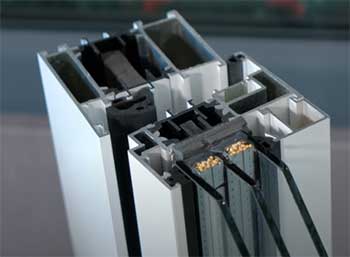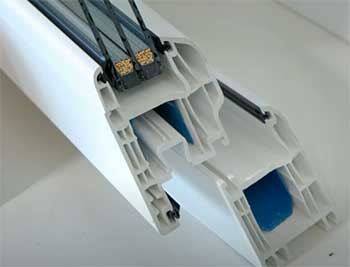When it comes to selecting new windows for your home, one of the most important considerations is the type of frame material. The two most popular options on the market today are thermally broken aluminium and uPVC (unplasticized polyvinyl chloride). But which one is the better choice?
In this comprehensive guide, we’ll examine the pros and cons of each type of window frame to help you decide.
A Brief Comparison Table
| Factor | Thermally Broken Aluminum | uPVC |
| Durability | Very high, 40+ years | Moderate, 20-30 years |
| Strength | Excellent | Moderate |
| Energy Efficiency | Excellent with thermal breaks | Good |
| Noise Reduction | Good | Very good |
| Appearance | Highly customizable, modern aesthetic | Limited options, mimics woodgrain well |
| Cost | Expensive upfront, lower lifetime cost | Cheap upfront, higher lifetime cost |
| Sustainability | Highly sustainable and recyclable | Not easily recyclable |
| Maintenance | Very low | Very low |
| Design Flexibility | Endless options for shapes and styles | Fairly limited, standard shapes |
| Thermal Performance | Excellent with multi-layered glass units | Good |
| Impact Resistance | Excellent | Moderate |
| Forced Entry Resistance | Excellent | Moderate |
| Weather Resistance | Excellent, resists all climates | Moderate, plastic degrades over time |
Thermally Broken Aluminium Window Frames
Aluminium is a metal that has been used for window frames for decades. It offers many benefits:
- Strength and Durability
One of the main advantages of aluminium is its superior strength and durability compared to uPVC and wood frames. Aluminium can withstand high winds, driving rain, and extreme temperatures without warping, expanding, contracting, or deteriorating over time.
Aluminium window frames have a lifespan of 40 years or more with proper maintenance.
- Low Maintenance
Aluminium needs very little maintenance other than occasional cleaning. It does not peel, crack, warp, or rot. Its durable powder coated finish resists scratches and reduces cleaning needs.
- Design Flexibility
Aluminium can be extruded into just about any shape and style, allowing for custom windows and creative designs. Frames can have rounded corners, decorative carvings, historical profiles, and more. The material can also be finished in a wide range of colours.
- Energy Efficiency

Plain aluminium conducts heat very well, which is great for pots and pans but not for windows.
That’s why thermally improved or thermally broken aluminium was developed.
This incorporates a thermal barrier into the frame, usually a polyurethane strip, that separates the exterior and interior aluminium to provide a thermal break.
This drastically reduces heat transfer and improves insulation.
Thermally broken aluminium windows can meet and even exceed Energy Star requirements for most climate zones. Models with double or triple glazing provide excellent thermal performance.
- Environmentally Friendly
Aluminium is sustainable and recyclable material. Modern smelting processes have also reduced its carbon footprint significantly. Thermally broken aluminium windows are an eco-friendly choice.
- Cost
Thermally broken aluminium windows are on the expensive side. The initial investment is higher than uPVC, but aluminium windows will outlast uPVC by decades. Their longevity offsets the higher upfront cost.
uPVC Window Frames
uPVC stands for unplasticized polyvinyl chloride. It’s a durable, long-lasting plastic that’s become the most commonly used window frame material. Here are its advantages:
- Affordability
uPVC windows are generally the most affordable frame option. uPVC is an inexpensive plastic resin. It’s easy to manufacture frames from standard profile extrusions on a mass scale, keeping production costs low. Installation costs are low too.
- Low Maintenance
Like aluminium, uPVC requires very little maintenance over its lifespan. It won’t rot, peel, crack, or warp. You’ll never need to paint or stain uPVC frames.
- Energy Efficient

uPVC has low thermal conductivity, giving it good insulating properties.
Multi-chambered frame profiles with air pockets further reduce heat transfer.
uPVC window frames can meet Energy Star requirements in most climate zones when paired with Low-E glass coatings, inert gas fills, and multi-point locks.
- Noise Reduction
The dense, rigid plastic of uPVC blocks outdoor noise better than many other framing materials. Multi-chambered profiles improve acoustical insulation further.
- Appearance
uPVC offers a clean, consistent look. Frames are white or a tinted color all the way through, with no need for paint that can chip or peel. Modern uPVC windows often mimic the look of wood grain quite convincingly.
- Health and Safety
uPVC doesn’t rot or attract mold and mildew like wood can. It doesn’t rust or conduct electricity. uPVC is also fire-resistant and releases no toxic fumes if burned. No harmful chemicals leach from uPVC either.
Key Differences Between Thermally Broken Aluminium And uPVC Frames
Now let’s do a direct side-by-side comparison of some key factors:
Durability and Longevity
- Aluminium is one of the most durable framing materials. Thermally broken aluminium windows last 40+ years.
- uPVC windows last around 20-30 years on average. Their plastic material is susceptible to sun damage and degradation over time.
Energy Efficiency
- With thermal breaks, aluminium windows can meet Energy Star requirements in any climate. Multi-layered glass units provide excellent insulation.
- uPVC windows also achieve good thermal performance. But plastic is a less effective insulator than aluminum with thermal breaks.
Appearance
- Aluminium offers endless design flexibility with custom shapes and finishes. It provides a modern, high-end look.
- uPVC is limited to basic shapes and tinted white colors. But woodgrain finishes offer a traditional aesthetic.
Environmental Impact
- Aluminium is highly sustainable and recyclable. Modern production reduces its carbon footprint.
- uPVC is not easily recyclable. Production involves the use of chlorine gas, linked to dioxin formation.
Strength
- Aluminium is incredibly strong. It resists high winds, impact, and forced entry much better than uPVC.
- uPVC is not as structurally rigid or resilient. Reinforcements are needed to improve wind and impact resistance.
Cost
- Aluminium windows have a high upfront cost, but their longevity offsets this over the long run.
- uPVC windows are the most affordable type, making them popular despite their shorter lifespan.
Frequently Asked Questions (FAQ)
Aluminum is better when designed with thermal breaks. The polyurethane thermal barrier vastly reduces heat transfer. uPVC is a good insulator, but aluminum with breaks provides superior thermal performance.
It depends on your priorities. Aluminum is much stronger, more durable, and environmentally sustainable. But uPVC is more affordable upfront. Aluminum also offers more aesthetic options while uPVC mimics woodgrain well. Overall aluminum is higher quality but comes at a cost premium.
No, aluminum is far more durable than uPVC. Aluminum can last over 40 years, while uPVC degrades after 20-30 years on average. Aluminum withstands weathering and mechanical wear much better long-term.
The main advantages are:
1. Greater strength and impact resistance
2. Much longer lifespan (40+ years vs. 20-30 years)
3. Superior energy efficiency when thermally broken
4. More aesthetically appealing with endless design options
5. Environmentally sustainable and recyclable
The only real advantage of uPVC is lower upfront cost. But aluminum’s durability offsets that over the product lifetime.
Final Thoughts
So in summary, thermally broken aluminum offers superior strength, durability, appearance, and environmental sustainability compared to uPVC, while uPVC is more budget-friendly.
Make sure to factor in your climate, home style, budget, and timeline before deciding between the two.
